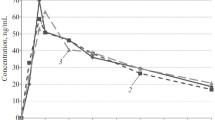Summary
Nine patients with essential hypertension completed a clinical trial designed to study the effects and side effects of administration and withdrawal of guanfacine (2 mg tds) and methyldopa (250 mg tds) on blood pressure, heart rate, and plasma noradrenaline. The study was of randomised doubleblind crossover design with two active therapy phases of eight weeks each, preceded by an initial 4 week placebo phase, separated by an intermediate 2 week placebo phase, and followed by a final 2 week placebo phase. Patients took bendrofluazide 5 mgs daily throughout the entire trial, during both active and placebo periods. Each patient was admitted to hospital at the end of the 8 week active treatment phases, so that the effects of drug withdrawal on blood pressure, heart rate, plasma noradrenaline and side reactions, could be closely observed and monitored. The main conclusions from analysis of the results were that:
-
1.
The hypotensive efficacy of guanfacine and methyldopa was very similar in the doses used, each of the two drugs lowering the supine mean arterial pressure by about 15 mm Hg and the supine diastolic pressure by about 10 mm Hg.
-
2.
The frequency of side effects was greater with guanfacine than with methyldopa.
-
3.
There was no signficant early rebound phenomenon after withdrawal of either methyldopa or guanfacine.
-
4.
There was tendency for the blood pressure to rise slowly and marginally above initial placebo values, 2 weeks after cessation of guanfacine treatment though this was not significant. It was however, accompanied by a significant increase in plasma noradrenaline at 2 weeks. This was not seen 2 weeks after cessation of methyldopa. There was no single incidence of worrying rebound hypertension or withdrawal symptoms either early or late in any patient following cessation of methyldopa or guanfacine.
Similar content being viewed by others
References
Burden AC, Alexander CPT (1976) Rebound hypertension after acute methyldopa withdrawal. Br Med J 1: 1056–1057
Dubach UC, Huwyler R, Radielovic P, Singeisen M (1977) A new centrally acting antihypertensive agent guanfacine (BS100-141). Arzneim Forsch 27: 674–676
Frewin DB, Penhall RK (1977) Rebound hypertension after sudden discontinuation of methyldopa therapy. Med J Aust 1: 659
Henry DP, Starman BJ, Johnson DG, Williams RH (1979) A sensitive radioenzymatic assay for norepinephrine in tissues and plasma. Life Sci 16: 375–384
Hunyor SN, Hansson L, Harrison TS, Hoobler SW (1973) Effects of clonidine withdrawal: possible mechanisms and suggestions for management. Br Med J 2: 209–211
Jäättelä A (1976) Clinical efficacy of BS100–141 in essential hypertension. A single-blind pilot study. Eur J Clin Pharmacol 10: 69–72
Jarrott B, Louis WJ, Summers RJ (1979) The effect of a series of clonidine analogues on3H-clonidine binding in rat cerebral, cortex. Biochem Pharmacol 27: 141–144
Oates HF, Stoker LM, MacCarthy EP, Monaghan JC, Stokes GS (1978) Comparative haemodynamic effects of clonidine and guanfacine. Arch Int Pharmacodyn Ther 231: 148–156
Reid JL, Wing LMH, Dargie HJ, Hamilton CA, Davies DS, Dollery CT (1977) Clonidine withdrawal in hypertension: changes in blood pressure and plasma urinary noradrenaline. Lancet 1: 1171–1174
Saameli K, Scholtysik G, Waite R (1975) Pharmacology of BS100-141, a centrally active antihypertensive drug. Clin Exp Pharmacol Physiol (Suppl) 2: 207–212
Salzmann R (1979) The effects of treatment and of withdrawal of treatment with guanfacine and clonidine on blood pressure and heart rate on nomrotensive and renal hypertensive rats. J Pharm Pharmacol 31: 212–216
Seedat YK (1978) Long-term treatment of hypertension with guanfacine (BS100–141) alone and in combination therapy. Curr Ther Res Clin Exp 24: 288–298
Shaw J, Hunyor SN, Korner PI (1971) The peripheral circulatory effects of clonidine and their role in the production of arterial hypotension. Eur J Pharmacol 14: 101–111
Scholtysik G, Lauener H, Eichenberger E, Bürki H, Salzmann R, Muller-Schweinitzer E, Waite R (1975) Pharmacological actions of the antihypertensive agent N-amidino-2-(2,6-dichlorophenyl) acetamide hydrochloride (BS100-141). Arzneim Forsch 25: 1483–1491
Author information
Authors and Affiliations
Rights and permissions
About this article
Cite this article
Bune, A.J., Chalmers, J.P., Graham, J.R. et al. Double-blind trial comparing guanfacine and methyldopa in patients with essential hypertension. Eur J Clin Pharmacol 19, 309–315 (1981). https://doi.org/10.1007/BF00544579
Received:
Accepted:
Issue Date:
DOI: https://doi.org/10.1007/BF00544579




